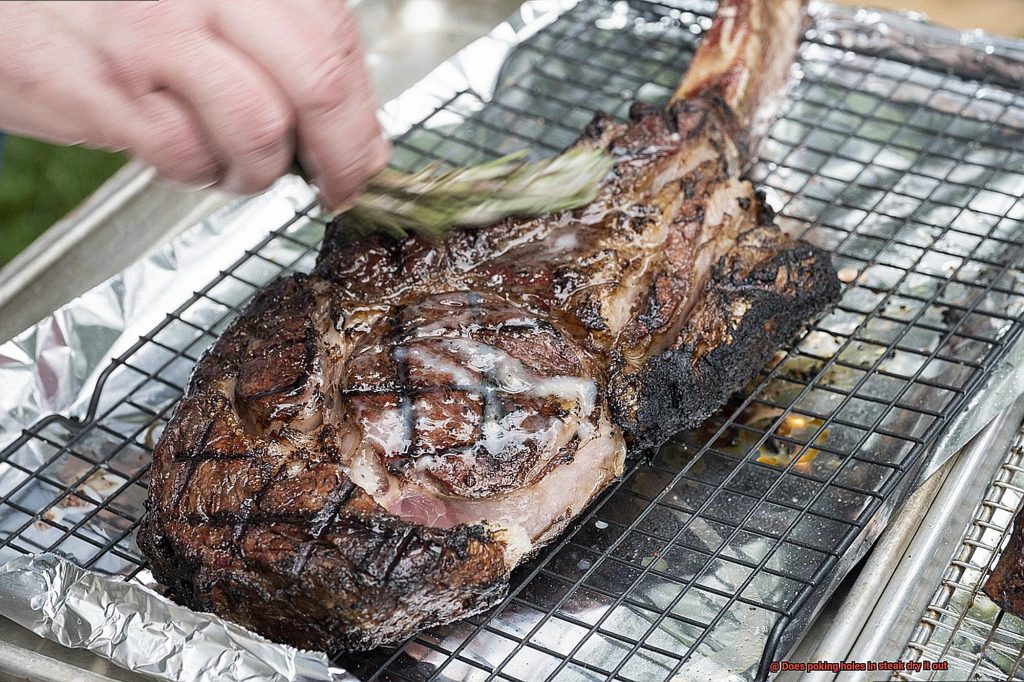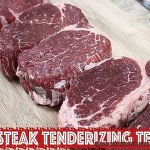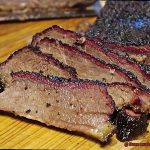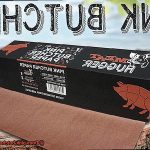Are you a steak lover who’s always on the hunt for the juiciest, most succulent cuts? If so, you may have heard some conflicting opinions about whether or not poking holes in steak can actually dry it out. Some chefs swear by this technique, while others caution against it. So, what’s the truth? Can poking holes in a steak really dry it out?
The idea behind poking holes in steak is to allow marinades or seasonings to penetrate the meat more deeply, resulting in a more flavorful steak. However, some people worry that by creating these holes, the juices inside the steak will escape and lead to a dry, tough end result.
To get to the bottom of this debate, let’s dive into the science behind how meat cooks. As heat is applied to the steak, its juices are pushed towards its center. By poking holes in it, some of these juices may escape and evaporate during cooking, leading to a drier end product. But don’t panic just yet. If your steak is properly cooked and rested after cooking, any lost juices can quickly be reabsorbed into the meat fibers. This results in a juicy and flavorful final product.
So does poking holes in steak really dry it out? The answer is yes and no. It all depends on how well you cook your meat and whether you give it enough time to rest before digging in. By focusing on proper cooking techniques and seasoning methods that bring out the natural flavors of your cut of beef – rather than obsessing over whether or not to poke those little holes – you’ll be sure to enjoy a tender and delicious meal every time.
Contents
What is the purpose of poking holes in steak?
You may want to reconsider this technique. While it is true that puncturing small holes in the meat can help tenderize it and allow marinades or seasonings to penetrate deeper, experts caution against this practice. The reason being, when the holes are made, the juices from within the meat are released, causing it to lose moisture and become dry.
However, if you insist on poking holes in your steak, there are a few things you need to keep in mind. Size and number matter. If too many or too large of holes are made, then more juice will be lost, resulting in a drier steak. On the other hand, if only a few small holes are made, then it may not have much of an impact on the moisture content.
Rather than poking holes, focus on proper seasoning and cooking technique. Season your steak with salt and pepper or your favorite seasoning blend and let it sit at room temperature for about an hour before grilling. This will help the steak cook more evenly and develop a nice crust on the outside.
When it comes to cooking technique, there are a few different methods you can try. One popular option is the reverse sear method, which involves cooking the steak low and slow in the oven before finishing it off on the grill. Another option is to sear the steak first and then finish it off in the oven. Both of these methods can help you achieve a juicy and flavorful steak without having to poke any holes.
Finally, make sure to let your steak rest for a few minutes after cooking before slicing into it. This allows the juices to redistribute throughout the meat, resulting in a more tender and flavorful final product.
What are the dangers of poking holes in steak?
As an expert on all things steak, I have researched the dangers of this seemingly harmless technique. And let me tell you, it’s not worth the risk.
First and foremost, poking holes in your steak can cause it to dry out. The juices that make your steak tender and juicy will escape through the holes, leaving behind a tough and dry piece of meat. If you’re looking for a delicious steak experience, avoid poking any unnecessary holes.
But that’s not the only danger. Poking holes in your steak can also lead to uneven cooking. The thinner areas created by the holes will cook faster than the rest of the meat, resulting in overcooked spots and undercooked spots. So, if you want to avoid a disappointing meal, leave your steak intact.
And let’s not forget about contamination. When you puncture the surface of your meat, you’re creating an entry point for harmful bacteria and microorganisms. If they are present on the surface of your meat, they can easily make their way inside and cause foodborne illness. No one wants to risk their health for a piece of steak.
To ensure a safe and delicious steak experience, focus on seasoning and cooking techniques that enhance the flavor and texture of your meat. Try the reverse sear or searing first then finishing in the oven for optimal results. And don’t forget to let your steak rest before slicing into it for maximum juiciness.
What are some alternatives to poking holes?
In fact, this misguided method can leave your steak dry and tough. Fortunately, there are several alternatives that will result in a more tender and juicy meal.
One popular alternative is marinating. By soaking your steak in a flavorful liquid for several hours or overnight, the acids in the marinade break down the muscle fibers in the meat, resulting in a more tender and juicy steak. Plus, the flavors from the marinade penetrate deep into the meat, adding an extra layer of deliciousness.
Another option is to use a meat mallet. This handy tool has small spikes on one side that are designed to break down the muscle fibers without piercing the meat. Simply pound your steak with the mallet until it reaches your desired level of tenderness.
But how do you ensure that your steak is cooked perfectly without drying it out? The answer is simple: use a meat thermometer. Overcooking is often the culprit when it comes to tough and dry steak, so using a thermometer to monitor the internal temperature can help prevent this issue.
Finally, allowing your steak to rest after cooking is crucial to keeping it moist and juicy. When you remove your steak from the heat source, let it sit for a few minutes before slicing into it. This allows the juices to redistribute throughout the meat, resulting in a tender and flavorful steak.
Does needling steak help with tenderness?
From marinades to meat mallets, there are countless methods to achieve the desired tenderness. But have you considered needling? Can puncturing your steak with tiny needles improve its tenderness? The answer is yes, but with some important details to consider.
To start, let’s understand how connective tissues work in meat. These tissues are responsible for holding muscle fibers together and are made up of collagen, elastin, and other proteins. When cooked properly, these tissues break down into gelatin, which gives meat its tender and juicy texture.
However, sometimes these tissues don’t break down enough, resulting in tough and chewy meat. This is where needling comes in. By using a tool with small needles or blades to create tiny holes in the meat, you’re essentially making it easier for those connective tissues to break down during cooking.
Research has shown that needling can indeed improve the tenderness of certain cuts of meat, such as round steak or flank steak. In fact, some commercial meat processors use needling machines to improve the texture of their products. But, it’s important to note that there is a risk of drying out the meat if it’s not cooked properly.
When the meat is pierced, juices can escape more easily during cooking, leading to a drier end result. So it’s crucial to cook the steak correctly – either by searing it quickly over high heat or by slow-cooking it to allow the connective tissues to break down slowly.
In conclusion, needling steak can be an effective technique for achieving tender and juicy results. However, like any cooking method, it’s essential to experiment and find what works best for your preferred cut of steak. Here are some additional tips to help you perfect your needling technique:
- Only use a jaccarding tool on cuts of meat with tough connective tissues.
- Avoid over-needling the meat as it can lead to dryness.
- Always cook your steak properly to avoid drying it out.
- Experiment with different cooking methods and times to find what works best for you.
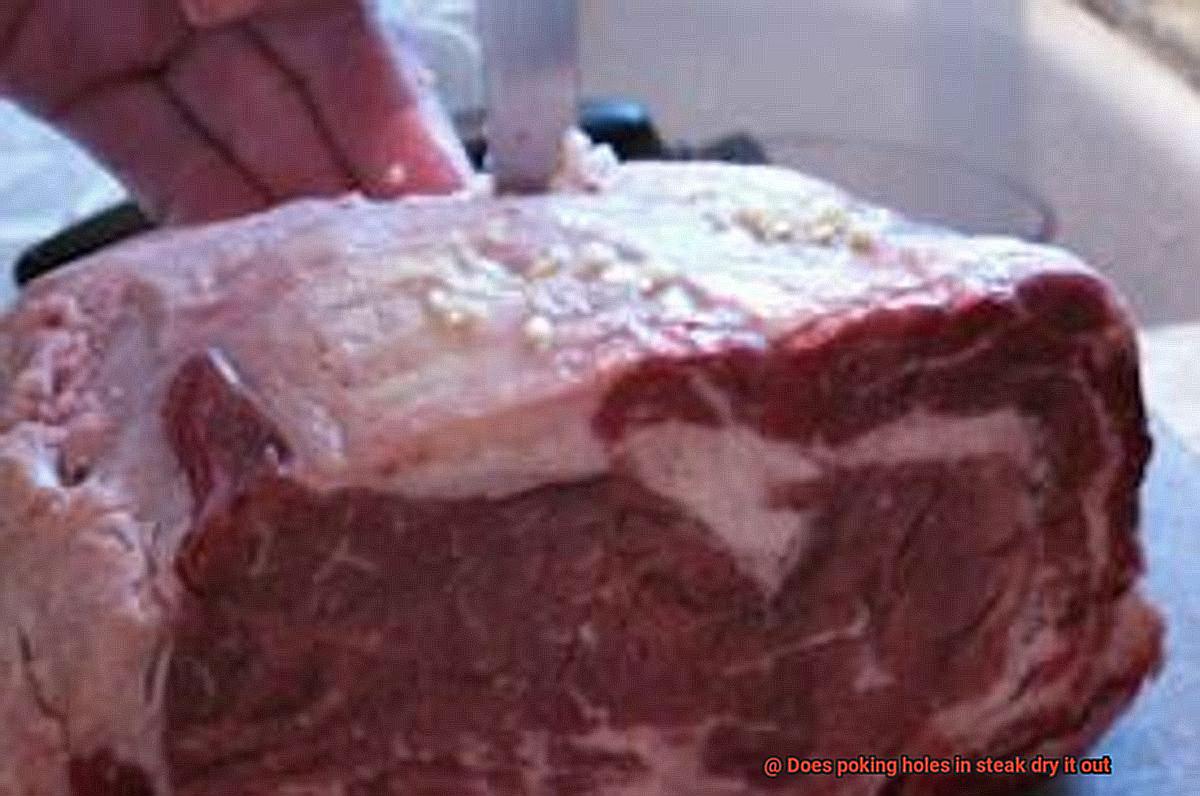
How to properly season a steak before grilling?
Grilling a steak is an art form that requires precision and attention to detail. One of the most important aspects of cooking a steak is seasoning it properly before grilling. Here are some tips on how to take your steak to the next level:
Start with a High-Quality Cut of Meat
When it comes to grilling a steak, quality is everything. Look for well-marbled steaks with visible fat, which will help keep the meat moist during cooking. Choosing a high-quality cut of meat will ensure that your steak is tender and juicy.
Liberally Season with Salt and Pepper
Salt and pepper are the foundation of any good steak seasoning. Generously sprinkle both sides of the steak with salt and pepper before grilling. The salt will not only enhance the flavor but also help draw moisture to the surface, creating a delicious crust when grilled.
Add Additional Seasonings Sparingly
While salt and pepper are essential for a perfect steak, additional seasonings can be used to add more flavor. Some popular options include garlic powder, onion powder, paprika, cumin, and chili powder. However, it’s important not to go overboard with seasoning as it can overpower the taste of the meat. A light touch is key.
Let the Steak Rest at Room Temperature
Before grilling your steak, let it sit at room temperature for about 30 minutes. This will help ensure even cooking and allow the flavors to penetrate the meat fully. If you cook a cold steak straight from the refrigerator, you risk ending up with a dry and tough piece of meat.
Use Oil or Butter Sparingly
Adding a small amount of oil or butter to your steak before grilling can help prevent sticking and enhance the flavor. But be careful not to add too much oil as this can cause flare-ups on the grill. Use a light hand when adding oil or butter and spread it evenly over both sides of the meat.
What techniques should be used for grilling steak?
Grilling steak is an art that requires precision and technique. By following some essential steps, you can easily achieve a juicy, flavorful, and succulent steak that will leave your guests or family impressed.
The first step in grilling steak is choosing the right cut of meat. Ribeye, sirloin, or filet mignon are excellent options that offer unique flavors and textures. Once you’ve made your selection, allow the steak to rest at room temperature before grilling. This helps the steak cook evenly and ensures a tender inside with a crispy outside.
Next up is seasoning. Generously season your steak with salt and pepper to enhance its natural flavors and create a delicious crust. You can also use additional seasonings like garlic powder, paprika, or rosemary for extra flavor. Brushing your steak with oil or butter helps prevent sticking and adds more flavor.
Properly preheating your grill is another critical technique for grilling steak. Before cooking, let your grill heat up for at least 10-15 minutes on high heat. This ensures that it reaches the right temperature for searing the steak perfectly. Don’t forget to clean your grill grates beforehand to avoid unwanted flavors transferring to your steak.
Timing is everything when it comes to grilling steak. Use a timer or thermometer to check if your steak is cooked to your desired level of doneness. For rare steaks, cook each side for 2-3 minutes, medium-rare for 3-4 minutes per side, and well-done for 5-6 minutes per side.
Finally, give your steak some rest time before cutting into it. This allows the juices to redistribute and ensures that the steak remains tender and juicy.
How long should you rest a steak after grilling?
Allowing your steak to rest is crucial as it allows the juices to redistribute throughout the meat, creating a more tender and flavorful bite. Additionally, resting your steak prevents all those precious juices from spilling out onto your plate or cutting board.
So, how long should you rest your steak? The general rule of thumb is to rest your meat for 5-10 minutes, depending on its thickness. For thicker cuts, a longer resting time is necessary, while thinner cuts can be rested for a shorter period. This gives the juices enough time to redistribute while ensuring that the meat doesn’t cool down too much.
It’s essential to keep your steak warm during the resting time by loosely covering it with foil or placing it in a warm oven. This ensures that the meat stays at a safe temperature while preserving its juiciness.
Here’s a pro-tip: don’t discard those juicy drippings. Pour them over your steak before serving or use them to make a sauce that will enhance the flavor of your dish.
It’s important to note that personal preference plays a significant role in determining how long to rest your steak. Some people prefer their steaks hot off the grill, while others enjoy them at room temperature. Experiment with different resting times and temperatures to find what works best for you.
2ua_v4BA3qM” >
Conclusion
In the world of steak grilling, there are countless techniques that people swear by. One such method is poking holes in the meat to allow marinades or seasonings to penetrate more deeply. However, this approach has sparked controversy as some experts caution against it, claiming that it can dry out the steak.
While it’s true that poking holes in a steak can cause some of its juices to escape and evaporate during cooking, leading to a drier end product, there’s no need to worry if your steak is cooked and rested correctly. Any lost juices can quickly be reabsorbed into the meat fibers.
Instead of obsessing over whether or not to poke those little holes, focus on proper seasoning and cooking techniques that bring out the natural flavors of your cut of beef. Season your steak with salt and pepper or your favorite seasoning blend and let it sit at room temperature for about an hour before grilling. This will help the steak cook more evenly and develop a nice crust on the outside.
When it comes to cooking technique, there are several options you can try – from reverse searing to searing first then finishing in the oven – that can help you achieve a juicy and flavorful steak without having to poke any holes.
Remember, personal preference plays a significant role in determining how long to rest your steak. Experiment with different resting times and temperatures until you find what works best for you.

